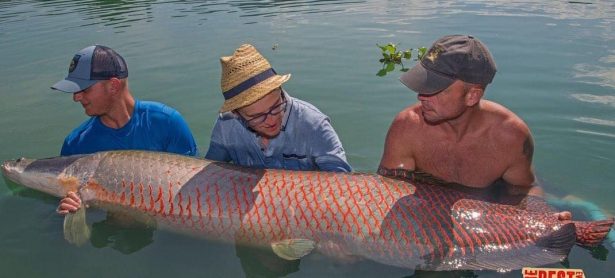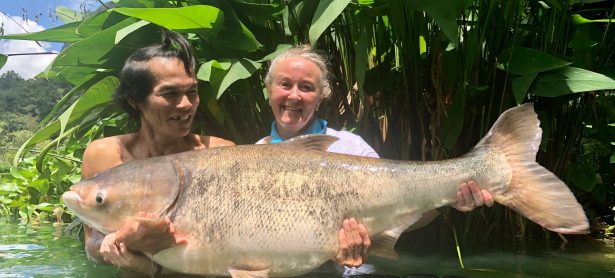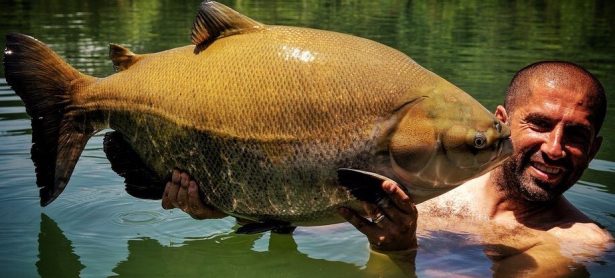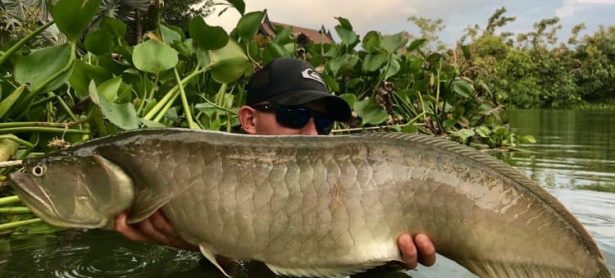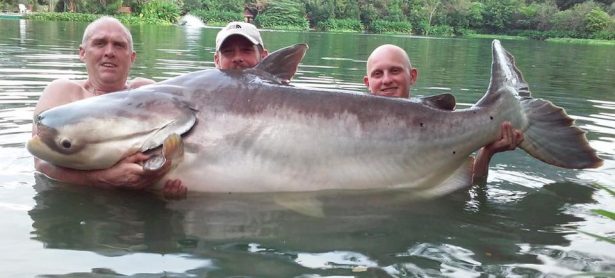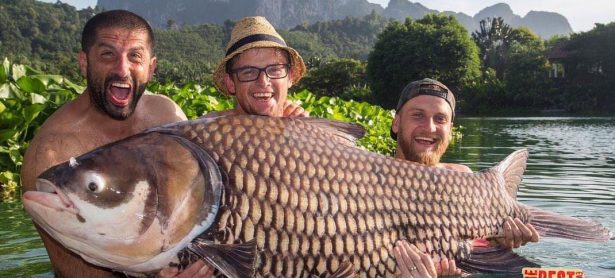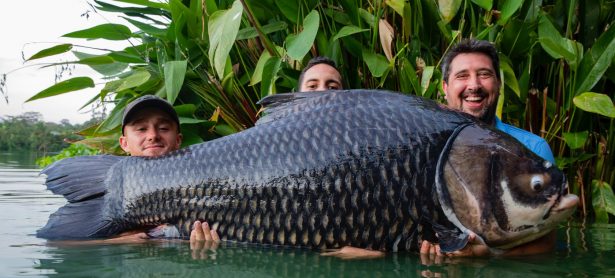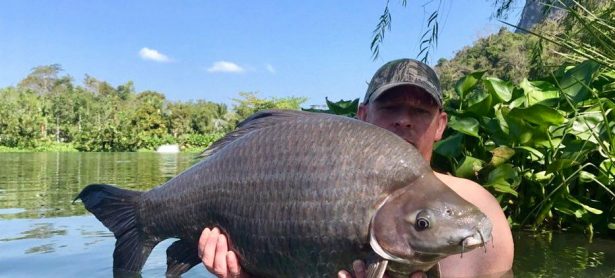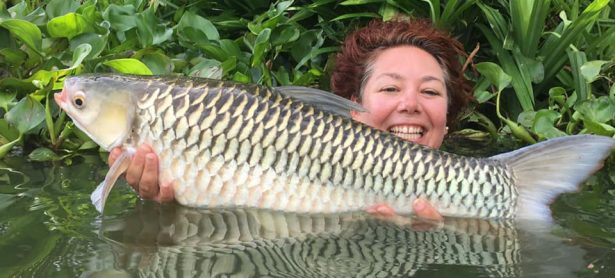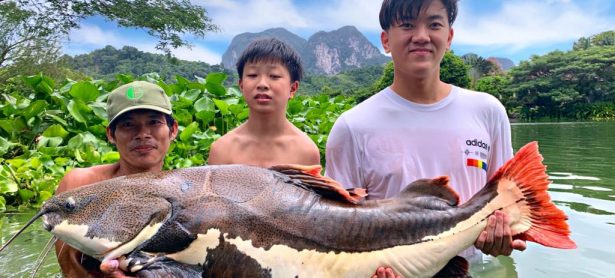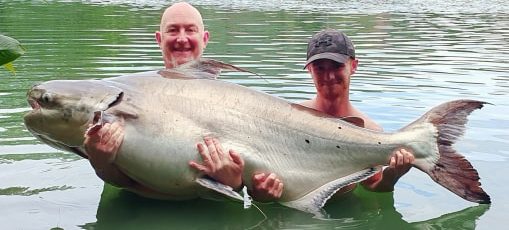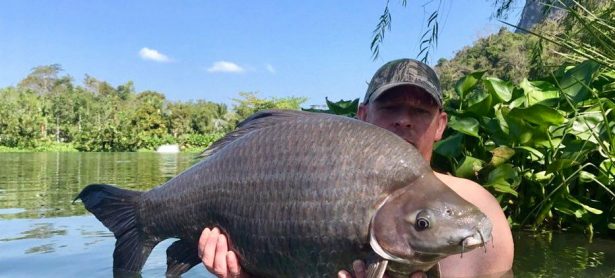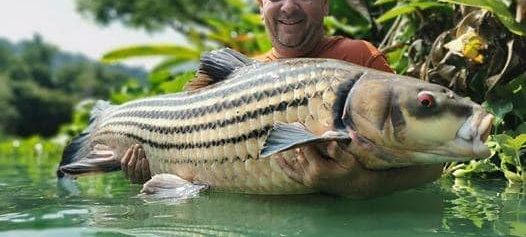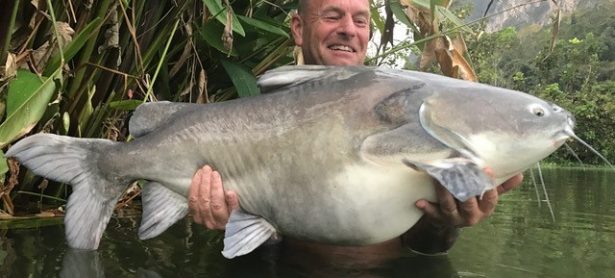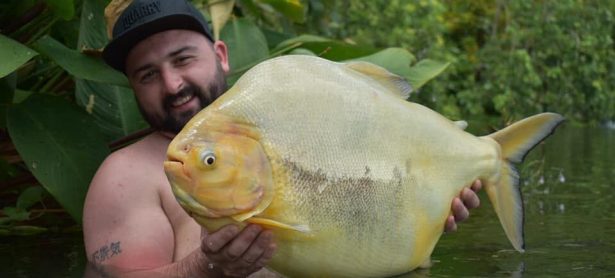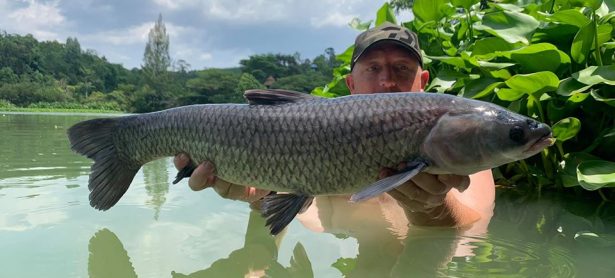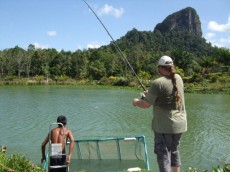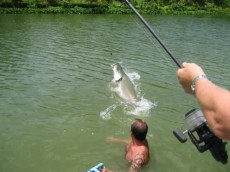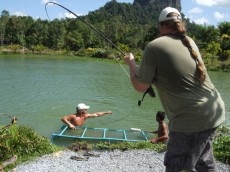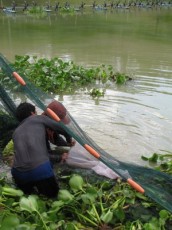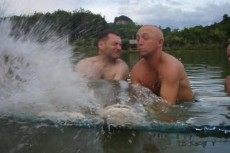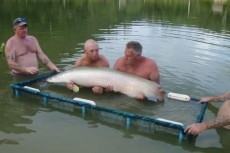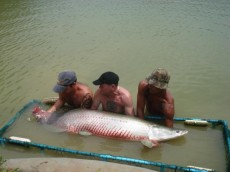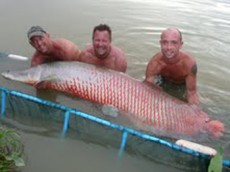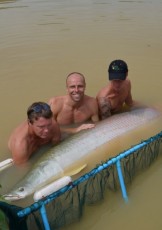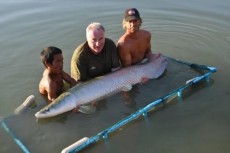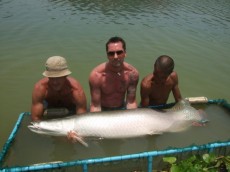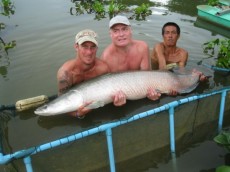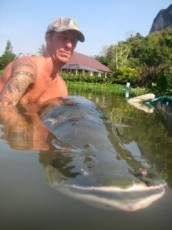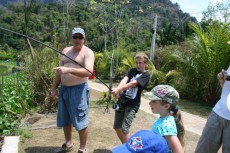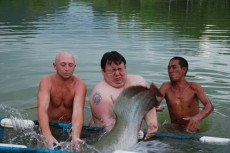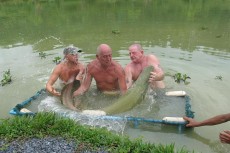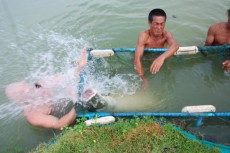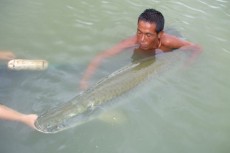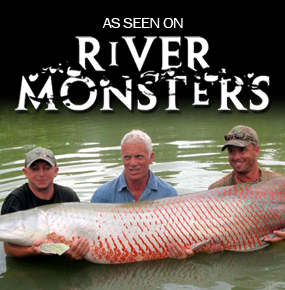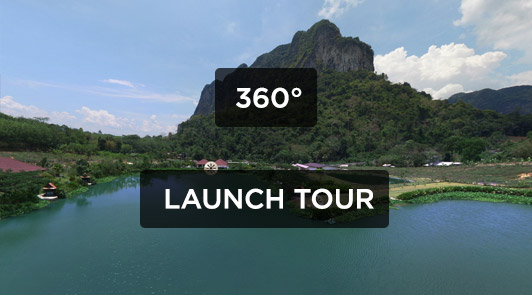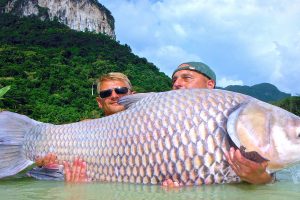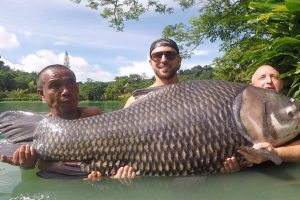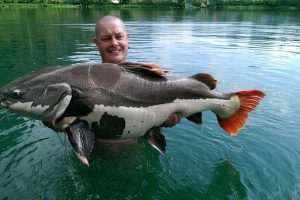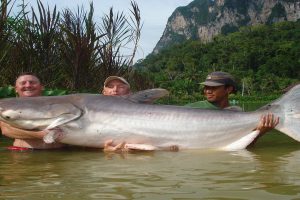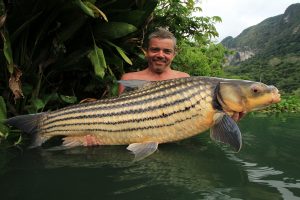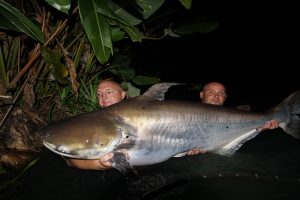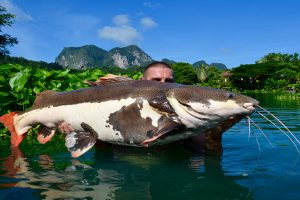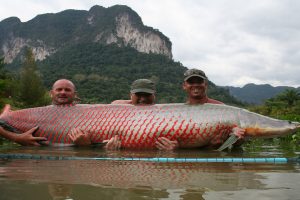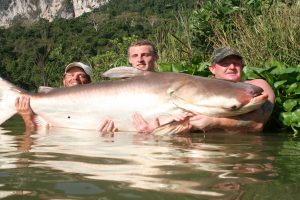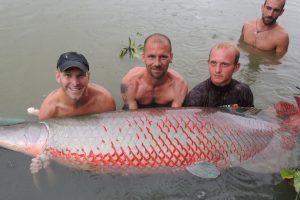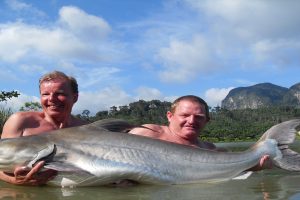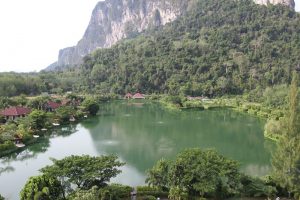 Name: Arapaima(pirarucu)
Name: Arapaima(pirarucu)
Species: Arapaima arapaima
Thai name: Pla tjon Amazon
Biggest known fish: 600LB
lake rod caught record: 560lb
Average weight: 180lb
Diet: Fish, boilie, pellet, frogs, small animals, reptiles and birds
To fish for our arapaima dead sea fish baits, boilies or pellets are the most effective, as since our fish are farmed and reared in captivity, sea fish and pellet are their diet.
Due to the size our arapaima have reached we have now banned all fly fishing on the main lake
Once an arapaima is hooked we have strict rules that must be adhered to. They are an extremely fragile fish once they reach 20kgs (45lbs), and in the past it was believed that all big arapaima die when caught.
We have developed techniques that give us a very successful release rate, but we lost a lot of big fish in the early days of fishing for these magnificent beasts. Now we are being followed by other conservation minded fisheries so you must heed our advice.
When hooked, if an arapaima jumps it is possible for them to die if their back bends the wrong way, and they can also cut the hooklink with their mouth plates and small teeth. As in tarpon fishing, ‘bow to the king’, and as the line rises for the fish to jump, quickly lower your rod to the left or right.
Once an arapaima is ready for netting we use a large floating plastic net cage; we place a guide at each end with a third man in front of the cage, so when the fish is ready to be caged we hold the leader and guide the fish into the cage.
The arapaima is in a handful of freshwater fish that has the ability to swim backwards as well as forwards, and they regularly power off on another run, so be ready at all times for the fish to swim off again.
Once in the cage the fish is allowed to take a breath of air, and then the hook is either removed or the hooklink cut. In our experience if you force an arapaima’s mouth open it damages the fish’s jaw, breaking a muscle lock, and the fish drowns.
We use barbless hooks, so cut or broken hooklinks are passed with ease by the fish. The fish is now allowed to surface and gulp two more breaths, so as this process is being waited for, get your cameraman ready and the camera focused, and remove all watches and jewelry.
Enter the water and approach the cage from behind the fish – never walk in front of the fish as they head-butt for defence, and with fish in excess of 400lbs this could be fatal to you. Our guides will advise you when to take your place in the middle of the fish while they take the head and tail ends for your safety.
We will roll the fish and sink the cage; we will no longer lift them, and you now have 60 seconds to take your trophy shots, after which the fish is rolled back to an upright position. We then wait for it to take one more breath, and at this point the angler must leave the water again from behind the fish.
Please be aware that under no circumstances will we allow an arapaima to be taken onto the bank – all photos will be taken in the water without the fish being lifted. For the fish’s safety we do not allow arapaima to be weighed, and as we have handled more arapaima than most people have ever seen, our estimated weights are accurate to within 5kg. Our decision on when the fish will be released is final, and we will never sacrifice a fish for a photo.
Safe Code of Conduct
Since this piece was written we have made a safe code of conduct for our arapaima, so please read the text below. To save any disappointment when you are here our rules and recommendations are final. By all means email us with your questions and concerns.
The arapaima is a fragile fish and great care is needed to catch and release them. We are not prepared to let such rare, beautiful fish die; arapaima die when caught unless they are bought in quickly using safe approved rigs.
How do you tell an angler who has already lost fish due to what they think are normal hook pulls to tighten the drag, get the rod to its full battle curve and get that fish in quickly, when they think if they play it slowly and gently the hook will not come out? Arapaima that are played slowly and allowed to sit on the bottom are the ones that die.
Arapaima can’t eject hooks, as they only open their mouths for seconds underwater to feed or they drown. 60% of arapaima come off when hooked due to the way they feed, which is to inhale their food. They open their mouths with force and inhale huge volumes of water, which is passed rapidly through flared gills, then their mouths shut rapidly. It’s all over in seconds, or they would drown!
Being air breathers means they can’t swim around with their mouths open, or feed like other species, mouthing bait then working it round in their lips to swallow at leisure. It’s a split-second decision – inhale and close – which is why they don’t take big baits. If a food item does not go in their mouth in seconds it can’t be eaten.
This 60% loss is due to them being hooked outside the mouth somewhere in their bony heads, caused by the rig holding the bait at a strange angle, which in turn causes a hook to set close to their mouth but not in it. At some stage in the fight the hook comes adrift, making the angler think the rig or hook is no good.
Without a rig attached their food comes directly into their mouth. “Yes,” I hear you say, “So why not freeline the bait?” This does work, and you do increase the chances of the bait being in their mouth, but the next problem with these prehistoric beasts is they have a lock system in their jaws to stop their mouths coming open.
If you force their mouths open the lock snaps, their mouth stays open, and they drown. Hence we use barbless hooks and short hooklinks to a feeder or similar that stops the rig going in to their mouths too far. We then cut the hooklink and the fish just passes the hook through its body.
Freelined baits go so far down their gut that when cut off with a meter or more of line, the line is passed out first, followed by the hook, but the long line can get caught up in underwater obstacles. Have you ever seen a fish that has engulfed a hook that’s trailing line, swallow it, and then pass the line out with the hook still inside its anus? We have and it is heartbreaking to see a magnificent creature rip itself to shreds and die on an entangled line!
Our findings are the facts, and changing hooks, or methods of striking and playing make no difference – hookholds outside the mouth come adrift; it’s just what will happen, and they come off! We have to insist people accept it and listen to us. There are no special rigs – hooked outside the mouth they come off! Once hooked in the mouth, that’s it, they stay put, and the only time they come off is when they jump and throw their mouths open, or if you bully them and the line snaps, but other than that the hook is not coming adrift.
We set the drags on reels to the perfect setting to land them safely and in a sensible time frame, which is why inexperienced anglers can land them. On big game fishing boats no one can touch the drag settings, and we have to do the same and insist people listen to us and accept that we know more than they do about our fish!
It’s a sad world really when 90% of anglers want photo or bust, but as I am also in the profit business we stock them! But we do learn about them, and we are still learning about them. We advise people only for them to formulate their own ideas and try to prove us wrong! We will keep experimenting, as we did when we became the first fishery to develop the safe release of big arapaima. We have to be strict on rigs, playing them, and handling them. Even though we handle hundreds of these fish every year we still get the anglers analyzing why they came off, not listening, and poo-pooing the only people who work, live, and try to learn about arapaima – US!
This is why we have taken the stand of, “Listen to us, do as we say, or please do not fish here!” It is actually easier to deal with average guys, rather than good fishermen in their own field – at least Mr. Average does listen more. So all you anglers coming over read this, take note and listen: there are no super rigs or hooks, the fact is 60% of your hooked arapaima will come adrift, so live with it or don’t fish for them!!
So when we tell you to tighten the drag or slacken off, listen! When we tell you that you can’t use your super-duper rig or hook, listen. We actually want you to catch our arapaima, which is why we stock them, but not at any cost. Circle hooks do work very well for arapaima and our catfish species; the only problem is 80% of anglers do not know how to use them. With circle hooks you cannot strike; you just let the line go tight to the fish. This is alien to most anglers, but strike and the hook comes out! If you are one of the anglers out there who can and has fished with circle hooks, then great, bring them over and use them – you will catch more.
Another rule we have introduced for arapaima safety is that we will no longer lift an arapaima above the water for a photo. From now on we will sink the cage and roll the arapaima on their sides for a picture. We have found that lifting them clear of the water does them no favours; they are so big it is a strain on their internal organs. You still get a cracking picture, but the fish is safer. Once again, as with our cages, we have learnt about fish care and safety through experience; we are at the forefront of arapaima catch and safe release. We intend to keep experimenting and learning and changing our rules, until we get a 100% safe release record.
Anyone who does not want to listen to our advice or abide by our rules please for your own sakes and ours do not come here. Our fish’s safety and health do, and always will, come before your trophy shots, or your idea of safe or effective rigs.
Arapaima Facts
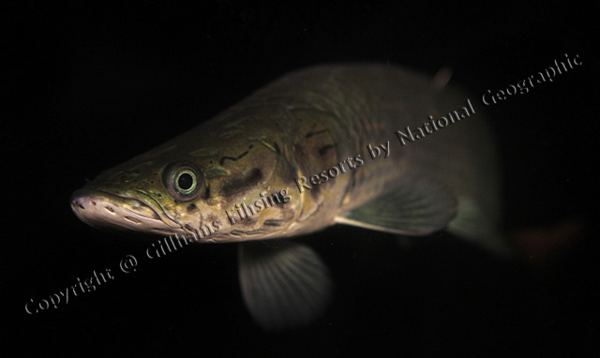
It has always been believed that arapaima were one species, scientists studies have revealed there are in fact five species of arapaima. It has recently being discovered that the species arapaima gigas no longer exists, the arapaima in Thailand are in fact arapaima arapaima. They are easy to tell from the other four known arapaima species, arapaima arapaima has a deeper caudal peduncle and has 31 rays in the caudal fin. The other four species have less than 18 rays and a narrow peduncle.
Arapaima are protected under CITES under the name A. gigas, since this species doesn’t appear to exist in the wild anymore, or hasn’t been discovered if it does. This raises questions over arapaima conservation, as it means the five species are not protected. Scientists are suggesting that the entire arapaima genus should be listed on CITIES appendix 2, this will give the fish urgently needed protection until more is known about this special fish.
Arapaima are the largest scaled freshwater fish in the world; they originate from the river Amazon in South America, and in the past they have been known to reach lengths in excess of 5m and weigh 400kg. Due to overfishing and destruction of their natural habitat very few if any this size exist in the wild today.
Arapaima first came to Thailand some 30 years ago for the aquarium trade, however due to their rapid growth rate they outgrew tanks very quickly. In the past they were then put into ponds where they thrived and grew as the climate here suits them more than their native homes.
The Thais grow them to breed from and as a food source, and in recent years they have found their way into commercial fisheries as a game fish. In the wild, arapaima have evolved and adapted to their hostile environment.
When the rivers rise they go in search of food in the flooded jungle, and as the flood waters recede they become trapped in flood ponds. As the oxygen depletes and other fish die, the arapaima evolved into an air breather, allowing them to feast on the dead and dying fish, then live in poor quality water till the next floods come.
In the wild arapaima spawn around February to April, scooping out a nest approximately 15cm deep in sandy bottoms, preferring depths up to 2m. The female arapaima is sexually mature at the age of five years old, and are typically 160cm in length at this point in their life.
The parental care includes helping to aerate the water for its offspring, which is a necessity for their survival in the oxygen-deficient waters of some habitats. Adults have the ability to exude a pheromone from their heads to attract offspring and keep them in close proximity.
The arapaima communicates with its offspring by means of attractive pheromones, which keep the offspring near. They lay 300 to 500 egg and guard the eggs until they hatch, the young arapaima stay with the male while the female keeps other fish away. He stays within 300cm of the lake’s surface as the young must breathe air every 60 seconds.
At eight weeks the young can be removed from the male with a fine net, but it is a risky situation as the female guards the young. At three months the parents will eat their young to control overcrowding. In Thailand arapaima spawn in between August to October after heavy rain and water coloration, in 2007 our lake had two spawning females now there are three. We leave the arapaima bred in the lake to come through naturally, every year around six new fish survive to become future stock.



